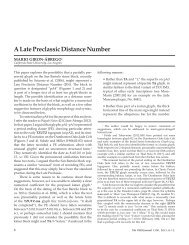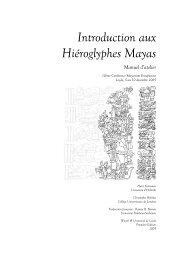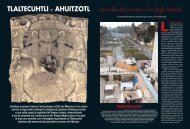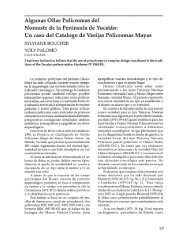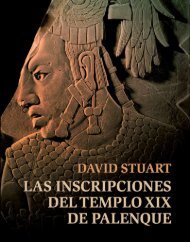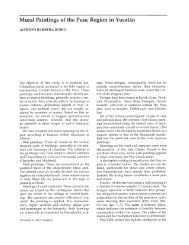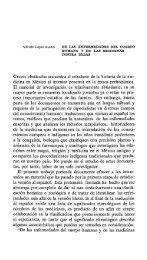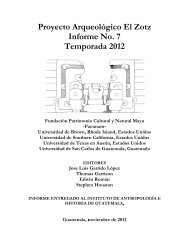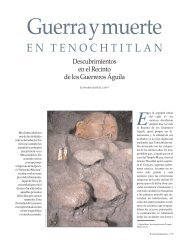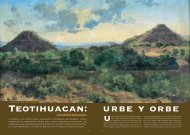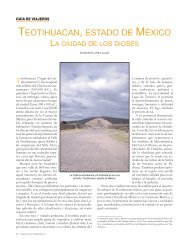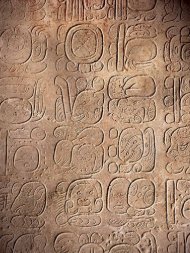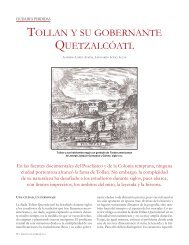Popol Vuh: Sacred Book of the Quiché Maya - Mesoweb
Popol Vuh: Sacred Book of the Quiché Maya - Mesoweb
Popol Vuh: Sacred Book of the Quiché Maya - Mesoweb
You also want an ePaper? Increase the reach of your titles
YUMPU automatically turns print PDFs into web optimized ePapers that Google loves.
Kukulcan. The supposedly Toltec-inspired Great Ballcourt at Chichen was dedicated on a<br />
date corresponding to November 18, 864, and current archaeological evidence indicates that all<br />
<strong>of</strong> <strong>the</strong> principal buildings <strong>of</strong> <strong>the</strong> city were completed well-before AD 1000 (Schele and<br />
Ma<strong>the</strong>ws 1998, 200).<br />
Ra<strong>the</strong>r than <strong>the</strong> result <strong>of</strong> a single event, such as <strong>the</strong> arrival <strong>of</strong> Kukulcan, central Mexican<br />
influence in <strong>the</strong> <strong>Maya</strong> world should be seen as a long continuum <strong>of</strong> mutual interaction<br />
extending back to at least <strong>the</strong> third or fourth century with <strong>the</strong> arrival <strong>of</strong> merchants and<br />
perhaps military invaders from <strong>the</strong> great central Mexican city <strong>of</strong> Teotihuacan. There is clear<br />
evidence <strong>of</strong> <strong>the</strong> presence <strong>of</strong> armed warriors from Teotihuacan who arrived at <strong>the</strong> largest <strong>of</strong><br />
lowland <strong>Maya</strong> centers, Tikal, in AD 378. There <strong>the</strong> foreigners oversaw <strong>the</strong> establishment <strong>of</strong> a<br />
new dynasty <strong>of</strong> heavily Mexican-influenced rulers, if not Teotihuacanos <strong>the</strong>mselves (Martin<br />
and Grube 2000, 29-36). That this was no isolated event is attested by <strong>the</strong> presence at about<br />
<strong>the</strong> same time <strong>of</strong> Teotihuacan architectural, ceramic, and artistic influences throughout <strong>the</strong><br />
<strong>Maya</strong> world, particularly in <strong>the</strong> Guatemalan highlands centered at <strong>the</strong> major site <strong>of</strong><br />
Kaminaljuyu (Kidder, Jennings, and Shook 1946; Sanders 1977; Michels 1979; Hatch 1997)<br />
and in <strong>the</strong> Tiquisate area (Hellmuth 1975, 1987; Bove 1989).<br />
Despite <strong>the</strong>se influences from central Mexico, Tikal and its neighbors maintained <strong>the</strong>ir<br />
fundamentally <strong>Maya</strong> character and within a brief time reestablished <strong>the</strong>ir own native<br />
dynasties. Chichen Itza as well, notwithstanding its taste for central Mexican motifs and<br />
concepts, was also likely ruled by native <strong>Maya</strong> lineages. Their claims to “Toltec” ancestry<br />
were part <strong>of</strong> <strong>the</strong> political climate <strong>of</strong> <strong>the</strong> age where such legendary Mexican connections were<br />
essential to establishing legitimacy based on ancient precedent. Schele and Ma<strong>the</strong>ws suggest<br />
that <strong>the</strong> Itza-<strong>Maya</strong> rulers <strong>of</strong> Chichen Itza used central Mexican imagery as a means <strong>of</strong><br />
proclaiming <strong>the</strong>mselves <strong>the</strong> legitimate inheritors <strong>of</strong> Toltec power in <strong>the</strong> same way that kings<br />
throughout Europe declared <strong>the</strong>mselves to be successors to <strong>the</strong> Holy Roman Empire,<br />
regardless <strong>of</strong> <strong>the</strong>ir familial and social histories (Schele and Ma<strong>the</strong>ws 1998, 201). Indeed <strong>the</strong><br />
18




